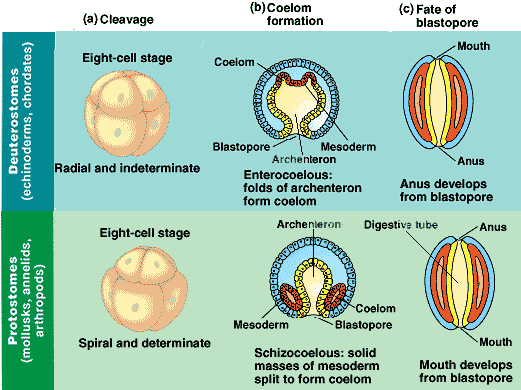

If a radially symmetrical animal is divided in any direction along the oral/aboral axis (the side with a mouth is “oral side,” and the side without a mouth is the “aboral side”), the two halves will be mirror images. It results in animals having top and bottom surfaces but no left and right sides, nor front or back. Radial symmetry is the arrangement of body parts around a central axis, as is seen in a bicycle wheel or pie.

All types of symmetry are well suited to meet the unique demands of a particular animal’s lifestyle. Bilateral symmetry is seen in the largest of the clades, the Bilateria ( (Figure) d) however the Echinodermata are bilateral as larvae and metamorphose secondarily into radial adults. (Although we should note that the ancestral fossils of the Parazoa apparently exhibited bilateral symmetry.) One clade, the Cnidaria ( (Figure) b,c), exhibits radial or biradial symmetry: Ctenophores have rotational symmetry ( (Figure) e). Asymmetry is seen in two modern clades, the Parazoa ( (Figure) a) and Placozoa. Developmental characteristics include the number of germ tissue layers formed during development, the origin of the mouth and anus, the presence or absence of an internal body cavity, and other features of embryological development, such as larval types or whether or not periods of growth are interspersed with molting.Īnimal Characterization Based on Body SymmetryĪt a very basic level of classification, true animals can be largely divided into three groups based on the type of symmetry of their body plan: radially symmetrical, bilaterally symmetrical, and asymmetrical. Symmetrical animals can be divided into roughly equivalent halves along at least one axis. The major feature of the body plan is its symmetry: how the body parts are distributed along the major body axis.

Animals have been traditionally classified according to two characteristics: body plan and developmental pathway. –>Scientists have developed a classification scheme that categorizes all members of the animal kingdom, although there are exceptions to most “rules” governing animal classification ( (Figure)). Compare and contrast the embryonic development of protostomes and deuterostomes.Explain the differences in animal body plans that support basic animal classification.Animal Nutrition and the Digestive Systemīy the end of this section, you will be able to do the following: Phylogenies and the History of LifeĨ7. Determining Evolutionary RelationshipsĨ8. Perspectives on the Phylogenetic Treeĩ0. Viral Evolution, Morphology, and Classificationĩ2. Prevention and Treatment of Viral Infectionsĩ3. Other Acellular Entities: Prions and Viroidsĩ6. Structure of Prokaryotes: Bacteria and Archaeaġ13. Green Algae: Precursors of Land Plantsġ25. The Evolutionary History of the Animal Kingdomġ29. Superphylum Lophotrochozoa: Flatworms, Rotifers, and Nemerteansġ30. Superphylum Lophotrochozoa: Molluscs and Annelidsġ31. Superphylum Ecdysozoa: Nematodes and Tardigradesġ47. Transport of Water and Solutes in Plantsġ54. Reproductive Development and Structure 6. Atoms, Isotopes, Ions, and Molecules: The Building Blocksġ0. Synthesis of Biological Macromoleculesġ8. Potential, Kinetic, Free, and Activation EnergyĢ5. Oxidation of Pyruvate and the Citric Acid CycleĢ8. Connections of Carbohydrate, Protein, and Lipid Metabolic Pathwaysģ2. The Light-Dependent Reactions of Photosynthesisģ3. Using Light Energy to Make Organic MoleculesĤ4. Mendel’s Experiments and the Laws of ProbabilityĤ8. Chromosomal Theory and Genetic LinkageĤ9. Chromosomal Basis of Inherited Disordersĥ1. Historical Basis of Modern UnderstandingĦ6. Eukaryotic Epigenetic Gene RegulationĦ7. Eukaryotic Transcription Gene RegulationĦ8. Eukaryotic Post-transcriptional Gene RegulationĦ9. Eukaryotic Translational and Post-translational Gene Regulation


 0 kommentar(er)
0 kommentar(er)
